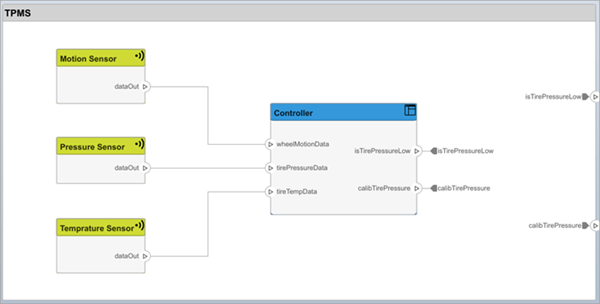Use allocations to analyze a tire pressure monitoring system.
Overview
In systems engineering, it is common to describe a system at different levels of abstraction. For example, you can describe a system in terms of its high-level functions. These functions may not have any behavior associated with them but most likely trace back to some operating requirements the system must fulfill. We refer to this layer (or architecture) as the functional architecture. In this example, an automobile tire pressure monitoring system is described in three different architectures:
Functional Architecture — Describes the system in terms of its high-level functions. The connections show dependencies between functions [1].
Logical Architecture — Describes the system in terms of its logical components and how data is exchanged between them. Additionally, this architecture specifies behaviors for model simulation [2].
Platform Architecture — Describes the physical hardware needed for the system at a high level [3].
Note: This example illustrates allocations in System Composer™ using a specific methodology. However, you can use other methodologies that fit your needs.
The allocation process is defined as linking these three architectures that fully describe the system. The linking captures the information about each architectural layer and makes it accessible to the others.
Use this command to open the project.
Open the FunctionalAllocation.mldatx file, which displays allocations from TPMS_FunctionalArchitecture to TPMS_LogicalArchitecture in the Allocation Editor. The elements of TPMS_FunctionalArchitecture are displayed in the first column. The elements of TPMS_LogicalArchitecture are displayed in the first row. The arrows indicate the allocations between model elements.
The arrows display allocated components in the model. You can observe allocations for each element in the model hierarchy.
The rest of the example shows how to use this allocation information to further analyze the model.
Functional to Logical Allocation and Coverage Analysis
This section shows how to perform coverage analysis to verify that all functions have been allocated. This process requires using the allocation information specified between the functional and logical architectures.
To start the analysis, load the allocation set.
Verify that each function in the system is allocated.
The result displays All functions are allocated to verify that all functions in the system are allocated and lists the allocations that have not been implemented.
Analyze Suppliers Providing Functions
This section shows how to identify which functions will be provided by which suppliers using the specified allocations. Since suppliers will be delivering these components to the system integrator, the supplier information is stored in the logical model.
The table shows which suppliers are responsible for the corresponding functions.
Analyze Software Deployment Strategies
You can determine if the Engine Control Unit (ECU) has enough capacity to house all the software components. The software components are allocated to the cores themselves, but the ECU is the component that has the budget property.
Get the platform architecture.
Load the allocation.
Build a table to showcase the results.
For each component in the ECU, accumulate the binary size required for each allocated software component.

